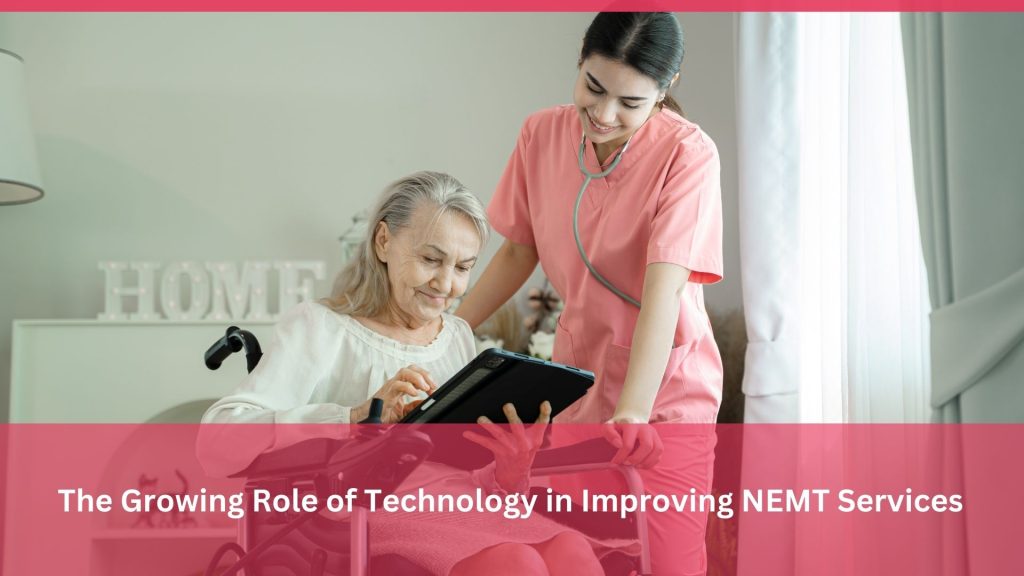New at Safr Care
The Growing Role of Technology in Improving NEMT Services

The Growing Role of Technology in Improving NEMT Services
Non-Emergency Medical Transportation (NEMT) providers have long supported patients by offering safe, reliable rides to medical appointments. However, as healthcare systems embrace digital solutions, NEMT services are also leveraging technology to streamline operations, enhance patient experience, and create more efficient workflows. This article explores how cutting-edge tools—like scheduling apps, route optimization software, and telehealth integration—are reshaping NEMT services, ensuring they adapt to modern healthcare demands while maintaining a commitment to compassionate care.
1. Advanced Scheduling and Dispatch Systems
Gone are the days when booking an NEMT ride relied solely on phone calls and manual calendars. Today, technology-driven scheduling platforms provide:
- Online and Mobile Booking: Patients, caregivers, or healthcare facilities can request rides through user-friendly websites or apps, receiving immediate confirmations.
- Automated Dispatch: Intelligent systems assign drivers based on route efficiency, vehicle type, and driver availability, speeding up the coordination process.
- Real-Time Updates: Automated notifications alert patients to pickup times or delays, enhancing transparency and reducing anxiety.
Such innovations minimize paperwork, lessen scheduling errors, and allow staff to focus on providing a more personalized experience for each patient.
2. Route Optimization and GPS Tracking
Navigating traffic, multiple pickups, and varying medical facility locations can be challenging. Route optimization tools and GPS tracking help NEMT providers to:
- Plan Efficient Itineraries: Software analyzes live traffic conditions and calculates the best routes, cutting travel time and fuel costs.
- Update Schedules Dynamically: Dispatchers can adjust routes as appointments change or traffic patterns shift, keeping rides on time.
- Offer Real-Time Monitoring: Patients and their families can track vehicles’ progress through apps or online portals, reducing uncertainty about arrival times.
By optimizing routes, NEMT providers ensure smoother journeys, increase on-time arrivals, and prevent overlapping trips that can frustrate patients.
3. Telehealth Integration and Community Coordination
The rise of telehealth has opened new avenues for NEMT. Providers are now collaborating with clinics and community programs to align rides with virtual healthcare services:
- Transport to Telehealth Hubs: Patients lacking reliable internet or devices at home can travel to designated community centers equipped with telemedicine stations.
- Seamless Scheduling: Automated systems sync virtual appointments with in-person visits, ensuring patients receive comprehensive and coordinated care.
- Access to Wellness Programs: NEMT can facilitate attendance at group sessions, nutrition classes, or support groups, even when these occur virtually or in hybrid formats.
This synergy strengthens patient engagement and offers a holistic healthcare approach, particularly for those in remote or underserved locations.
4. Enhanced Security and Compliance
As NEMT services collect sensitive patient data—like pickup addresses, medical facility details, and appointment schedules—ensuring privacy and regulatory compliance is paramount. Modern technology helps providers by:
- Secure, Encrypted Databases: Protecting personal health information (PHI) from unauthorized access through robust security protocols.
- HIPAA-Compliant Systems: Adhering to healthcare regulations that safeguard data exchange and patient confidentiality.
- Driver Verification Processes: Background checks, license monitoring, and digital identity confirmation reinforce trust and accountability.
Such measures reassure patients that their privacy is respected and that only authorized personnel handle crucial transport logistics.
5. Data Analytics for Continuous Improvement
Digitally transforming NEMT also means gathering insights that can refine operations and patient satisfaction. Some providers use analytics to:
- Track Key Metrics: Collect data on on-time performance, patient wait times, and route efficiency to identify opportunities for improvement.
- Predict Demand Patterns: Using historical ride volumes helps plan vehicle allocation, especially for peak days or times.
- Monitor Driver Performance: GPS and telematics provide details on driving behavior and adherence to safety protocols, guiding staff training.
By turning raw data into actionable strategies, providers can optimize scheduling, reduce operational costs, and improve the overall rider experience.
Choosing a Tech-Focused NEMT Provider
When selecting a NEMT service that leverages modern technology, look for those emphasizing:
- Online and Mobile Booking Options: Easy scheduling platforms or apps that patients and caregivers can navigate without hassle.
- Real-Time Communication: Automated ride updates and the ability to contact drivers or dispatchers directly.
- Security Certifications: Compliance with HIPAA and encryption standards protecting patient data.
- Data-Driven Enhancements: Providers that regularly review performance metrics and adopt improvements based on trends.
Companies like SafrCare align with these values, demonstrating how a tech-savvy approach can still retain a human-centered ethic, ensuring patient comfort and confidence.
Conclusion
In an era where healthcare is increasingly reliant on digital tools—from telehealth appointments to online patient portals—NEMT services are also evolving to offer a seamless, transparent, and efficient experience. By adopting advanced scheduling software, route optimization, GPS tracking, and robust data strategies, NEMT providers can significantly reduce wait times, missed appointments, and operational inefficiencies. This transformation not only benefits patients, who receive more reliable and user-friendly rides, but also strengthens collaboration between NEMT, healthcare facilities, and community programs.
Ultimately, these technological advancements help ensure that no one is denied access to essential medical care due to transport challenges. As NEMT services continue to innovate, patients stand to gain from faster, safer, and more personalized journeys—leading to better health outcomes and a more connected healthcare ecosystem.
